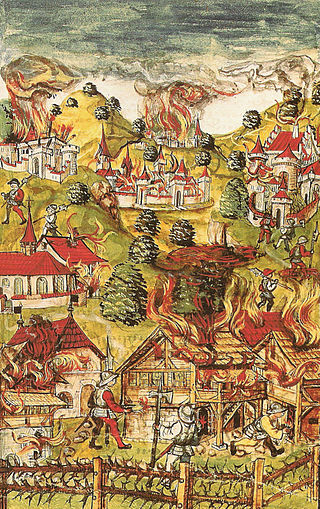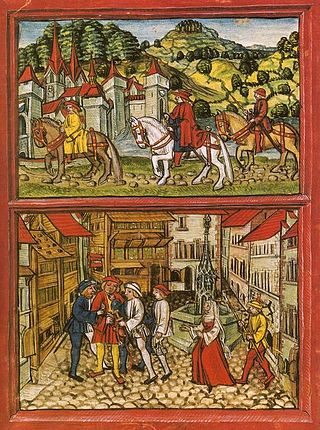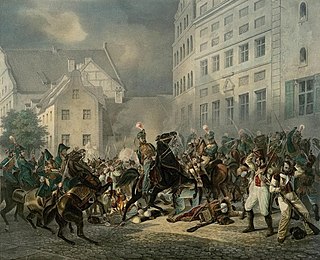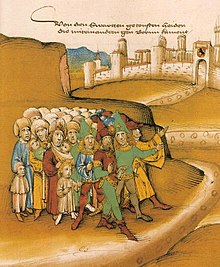Ronald Barnabas Schill is a former German judge, the founder of the German political parties Party for a Rule of Law Offensive and Pro DM/Schill. He served as the Senator of the Interior and Second Mayor in the government of Hamburg from 2001 to 2003.
George Kedrenos, Cedrenus or Cedrinos was a Byzantine Greek historian. In the 1050s he compiled Synopsis historion, which spanned the time from the biblical account of creation to his own day. Kedrenos is one of the few sources that discuss Khazar polities in existence after the sack of Atil in 969.

Several illustrated chronicles were created in the Old Swiss Confederacy in the 15th and 16th centuries. They were luxurious illuminated manuscripts produced for the urban elite of Bern and Lucerne, and their copious detailed illustrations allow a unique insight into the politics and daily life of late medieval Switzerland on the eve of the Reformation. The most important of these chronicles are the works of the two Diebold Schillings, their luxurious execution, as well as their content reflecting the growing confidence and self-esteem of the leaders of the confederacy after their spectacular successes in the Burgundian Wars.

Diebold Schilling the Elder was the author of several of the Swiss illustrated chronicles, the Berner Schilling of 1483, the Zürcher Schilling of 1484, and the Spiezer Schilling (1480s).

Diebold Schilling the Younger was the author of the "Luzerner Schilling", one of the Swiss illustrated chronicles, which he presented to the city council of Lucerne on 15 January 1513. He was the nephew of Diebold Schilling the Elder of Bern. The younger Diebold was a somewhat scandalous figure, not unlike his father Hans, brother to the elder Diebold, an adventurer who had sought his fortune at the court of Matthias Corvinus, and returned destitute in 1488. Diebold was a secretary in Lucerne from 1479, and received the priesthood in 1481. His behaviour was so unpriestly, however, that the city council locked him into the tower in 1487, where he remained imprisoned for two years before he was released on parole of exhibiting more appropriate behaviour in the future. After his release he was soon back to his old ways, and after he had killed a man after a tavern brawl, he was fined and obliged to read a mass for his victim every year. Diebold was fiercely anti-French, and he accused the Bernese in particular, as well as his fellow chronicler Petermann Etterlin because of their friendly attitude towards France. Diebold's own sympathies lay with the German emperor Maximilian I, who personally invited him to the Reichstag in Konstanz in 1507. As an author, Diebold's most important contribution to the historiography of his times is his account of the years 1507–1509, the events of which he tells in his own words as an eye-witness.

The Luzerner Schilling is an illuminated manuscript of 1513, containing the chronicle of the history of the Swiss Confederation written by Diebold Schilling the Younger of Lucerne.

The Berner Schilling is a chronicle of Diebold Schilling the Elder of Bern (1480s), covering the history of the Old Swiss Confederacy up to the Burgundian Wars.

Zürcher Schilling is the latest chronicle of Diebold Schilling the Elder of Bern (1484), treating the Burgundian Wars. It is kept in the central library in Zürich.

Wigand of Marburg was a German herald of the Teutonic Knights in Prussia and one of the notable chroniclers of the Middle Ages.
Werner Schodoler (also Wernher Schodoler was a Swiss chronicler. He was the author of Swiss History, the earliest of the Swiss illustrated chronicles.

The Zimmern Chronicle is a family chronicle describing the lineage and history of the noble family of Zimmern, based in Meßkirch, Germany. It was written in a Swabian variety of Early New High German by Count Froben Christoph of Zimmern (1519–1566). The chronicle is an eminent historical source of information about 16th century nobility in South-West Germany, its culture and its values. It is also an important literary and ethnological source for its many folkloristic texts. The text has survived in two manuscripts, both in possession of the Württembergische Landesbibliothek in Stuttgart.

The Burgerbibliothek of Berne is a public library located at Münstergasse 63 in Bern, Switzerland.

The Battle of Stralsund took place on 31 May 1809 during the Dano-Swedish War of 1808–1809 and the Franco-Swedish War, part of the Napoleonic Wars, between Ferdinand von Schill's freikorps and Napoleonic forces in Stralsund. In a "vicious street battle", the freikorps was defeated and Schill was killed in action.

The Swiss degen was a short sword, an elongated version of the Swiss dagger, with the same double-crescent shape of the guard. It was used as a type of side arm in the Old Swiss Confederacy and especially by Swiss mercenaries, from the first half of the 15th century until the mid 16th century. The native term used in the 15th century for this weapon was baselard. The term Schweizerdegen is first attested in 1499.

The Saubannerzug was a military campaign of irregular Swiss forces during the Fasnacht period of the year 1477, in the aftermath of the Battle of Nancy. It consisted of disgruntled men-at-arms from Central Switzerland who moved towards Geneva to enforce the payment of a sum of 24,000 Gulden owed to the Old Swiss Confederacy as ransom to escape looting.
Chronik der Wende is a German television series.

Gerold Edlibach was a Swiss chronicler and official of Zurich, author of the Zürcher Chronik.

Home from Home is a 2013 German drama film directed by Edgar Reitz. It was screened out of competition at the 70th Venice International Film Festival. It is shot in black and white, but there are some colour sequences. It is a prequel to the Heimat film series and concerns the Simon family living in the fictional Hunsrück village of Schabbach from 1840–1844.

Chronicles of the Gray House is a 1925 German silent historical drama film directed by Arthur von Gerlach and starring Paul Hartmann, Rudolf Forster and Lil Dagover.
Johannes Fründ was a Swiss clerk and chronicler.















